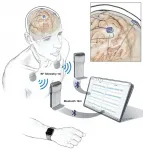(Press-News.org) Two of the most destructive forces of nature - earthquakes and tsunamis - might actually be more of a threat than current estimates according to new research conducted by scientists at The University of New Mexico and the Nanyang Technological University published today in Nature Geoscience.
The researchers developed a new method to assess earthquake and tsunami hazards represented by the most distant part of offshore subduction zones and found that the hazard might have been systematically underestimated in some areas, meaning that tsunami risk assessments should be redone given the new results. The findings have important implications for the mitigation of risk in affected areas worldwide, including Southeast Asia and the Pacific Rim, in the event of future earthquakes and tsunamis.
Megathrust earthquakes are among the most powerful earthquakes experienced worldwide and occur in subduction zones, where two tectonic plates converge, and one slides under the other. The plates move toward each other continuously, but if the interface, or fault, between them is stuck, then a slip deficit builds up over time. Like a debt, this slip deficit has to be paid off eventually, and for tectonic plates pay day is earthquake day. When these earthquakes affect the shallowest part of the fault near the seafloor, they have the potential to shift the seafloor upward and create devastating tsunamis as well.
Understanding the potential rupture behavior of megathrusts, particularly in the shallow offshore part of the fault where most destructive tsunamis are generated, is therefore a critical task for geoscientists forecasting seismic and tsunami inundation hazards. The likelihood of seismic behavior is often assumed to be somewhat low in the shallow part of the fault, based on laboratory studies of recovered fault zone material.
The fault's rate of slip deficit buildup can also be measured through the use of geodetic observations that track how the earth's surface moves over time, for example by using highly precise GPS sensors installed on land, together with a model that relates how slip on the fault affects the movement of these stations. However, it is hard for scientists to use this technique to "see" what is going on in the shallowest part of the fault, because it is far from land, below kilometers of water, where traditional GPS instruments cannot operate.
Now, scientists at The University of New Mexico and the Nanyang Technological University (NTU) in Singapore have developed a new geodetic method for inferring this value that accounts for the interaction between different parts of the fault, resulting in a much more physically accurate result. Lindsey's team noted that previous models have failed to take into account the fact that if the deep part of the fault is stuck between earthquakes, the shallow part can't move either - it is in what they term a 'stress shadow' and there is no buildup of energy available to cause it to slip. By taking this effect into account, the team developed a technique that uses the same land-based data but results in a vast improvement in their ability to "see" the fault slip in the areas that are farthest from shore, allowing researchers to reassess the hazard presented by the offshore parts of subduction zones most prone to tsunami generation.
"We applied this technique to the Cascadia and Japan subduction zones and found that wherever deeper locked patches are present, the shallow fault must also have a high slip deficit - regardless of its own frictional properties," said Eric Lindsey, an assistant professor in the UNM Department of Earth and Planetary Sciences who conducted the research while at the Earth Observatory of Singapore at NTU. "If these areas can slip seismically, global tsunami hazard could be higher than currently recognized. Our method identifies critical locations where seafloor observations could yield information about frictional properties of these faults in order to better understand their slip behavior."
This study is important because it calls for a reassessment of previous models of tsunami hazard on megathrusts worldwide. Because this can be done with existing data, the reassessment can be done comparatively quickly as well. Hopefully, this will lead to better preparedness among coastal communities for future events.
INFORMATION:
Other institutions involved in the research include the School of Earth Sciences, Energy and Environment, Universidad Yachay Tech, (Ecuador) and the Department of Earth and Planetary Science at the University of California Berkeley. The study is supported by the National Research of Singapore, the Singapore Ministry of Education and the National Science Foundation among others.
A grass commonly used to fight soil erosion has been genetically modified to successfully remove toxic chemicals left in the ground from munitions that are dangerous to human health, new research shows.
The study - led by the University of York- demonstrates that genetically modified switchgrass (Panicum virgatum) can detoxify residues of the military explosive, RDX, left behind on live-fire training ranges, munitions dumps and minefields.
RDX has been a major component of munitions since WW2 which are still used extensively on military training grounds. This use has now resulted in widespread pollution of groundwater.
Researchers generated the plants by inserting two genes from bacteria able to breakdown RDX. The plants were then grown in RDX contaminated ...
Researchers are now able to wirelessly record the directly measured brain activity of patients living with Parkinson's disease and to then use that information to adjust the stimulation delivered by an implanted device. Direct recording of deep and surface brain activity offers a unique look into the underlying causes of many brain disorders; however, technological challenges up to this point have limited direct human brain recordings to relatively short periods of time in controlled clinical settings.
This project, published in the journal Nature Biotechnology, was funded by the National Institutes of Health's ...
A research team led by City University of Hong Kong (CityU) scientists recently developed a new generation of microneedles technology which allows the intradermal delivery of living cells in a minimally invasive manner. Their experiment showed that vaccination using therapeutic cells through this ground-breaking technology elicited robust immune responses against tumours in mice, paving the way for developing an easy-to-use cell therapy and other therapeutics against cancers and other diseases.
The study was led by Dr Xu Chenjie, Associate Professor at the Department of Biomedical Engineering (BME) at CityU. The latest findings have been published in the scientific journal Nature Biomedical Engineering, titled "Cryomicroneedles for Transdermal Cell Delivery".
The new technology ...
Researchers at the National Institutes of Health (NIH) have devised a four-part small-molecule cocktail that can protect stem cells called induced pluripotent stem cells (iPSCs) from stress and maintain normal stem cell structure and function. The researchers suggest that the cocktail could enhance the potential therapeutic uses of stem cells, ranging from treating diseases and conditions -- such as diabetes, Parkinson's disease and spinal cord injury -- to genome editing.
Human pluripotent stem cells are cells that, in theory, can grow forever and serve as an inexhaustible source for specialized cells, such as brain, kidney and heart cells. But stem cells are sensitive, and their potential uses in ...
Tiny 3-D models that mimic vital aspects of the human nervous system have been developed in a step that could accelerate drug research for neurological conditions such as multiple sclerosis (MS).
The millimetre-wide models - created using stem cells from human skin samples - will be used to study myelin, an insulating substance that helps nerve cells communicate with each other.
Researchers say the models are the most natural representation of human myelination developed in a lab and are a promising platform for studying neurological diseases and for testing drugs for conditions linked to myelin loss, including MS.
Nerve cells are found in the brain and the spinal cord and connect to each other with ...
PHILADELPHIA - Belief in conspiracies about the COVID-19 pandemic increased through the early months of the U.S. outbreak among people who reported being heavy users of conservative and social media, a study by Annenberg Public Policy Center (APPC) researchers has found. ...
Many people in Switzerland experienced considerable psychological distress during the first COVID-19 lockdown from mid-March to the end of April 2020. Researchers from the Department of Child and Adolescent Psychiatry and Psychotherapy at the University Hospital of Psychiatry Zurich (PUK) and the University of Zurich in collaboration with the La Source School of Nursing have now examined the most common sources of stress among children, adolescents, their parents and young adults. For their study, the researchers used representative samples in Switzerland of 1,627 young adults aged 19 to 24 as well as 1,146 children and adolescents between the ages of 12 and 17 and their parents.
Uncertainty, disruption, postponement
"Uncertainty during last year's lockdown was considerable ...
HOUSTON - (May 3, 2021) - Ever look at a flatfish like a flounder or sole, with two eyes on one side of its head, and think, "How did that happen?"
You're in luck. Rice University biologist Kory Evans has the answer.
"Flatfishes are some of the weirdest vertebrates on the planet, and they got weird very, very fast by changing multiple traits at once over a short period of time," said Evans, an assistant professor of biosciences at Rice who specializes in studying the evolution of fish over long time scales.
Of all mammals, reptiles, birds, amphibians and fish, flatfish are easily the most asymmetric. Evans, the corresponding author ...
Biologists at Ludwig-Maximilians-Universitaet (LMU in Munich) have significantly enhanced the tolerance of blue-green algae to high light levels - with the aid of artificial evolution in the laboratory.
Sunlight, air and water are all that cyanobacteria (more commonly known as blue-green algae), true algae and plants need for the production of organic (i.e. carbon-based) compounds and molecular oxygen by means of photosynthesis. Photosynthesis is the major source of building blocks for organisms on Earth. However, too much sunlight reduces the efficiency of photosynthesis because it damages the 'solar panels', i.e. the photosynthetic machineries of cyanobacteria, algae and plants. A team of researchers led by LMU biologist Dario Leister has ...
New Haven, Conn. --Yale researchers have shown that developmental abnormalities, including those that lead to pregnancy loss and autism, are controlled by the genetics of the fetus and placenta -- and not the mother's intrauterine environment.
The findings are reported in the April 28 online edition of the journal Placenta.
One out of every 33 children is diagnosed with a birth defect each year in the United States, according to the Centers for Disease Control and Prevention (CDC). This translates into one baby born every 4 ½ minutes -- or 120,000 per year.
"Mothers ...



